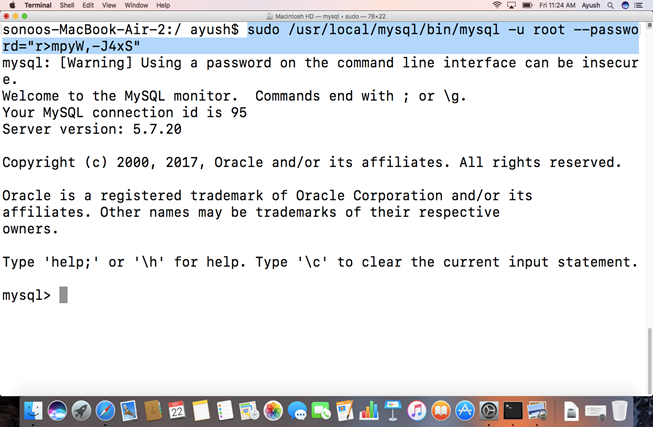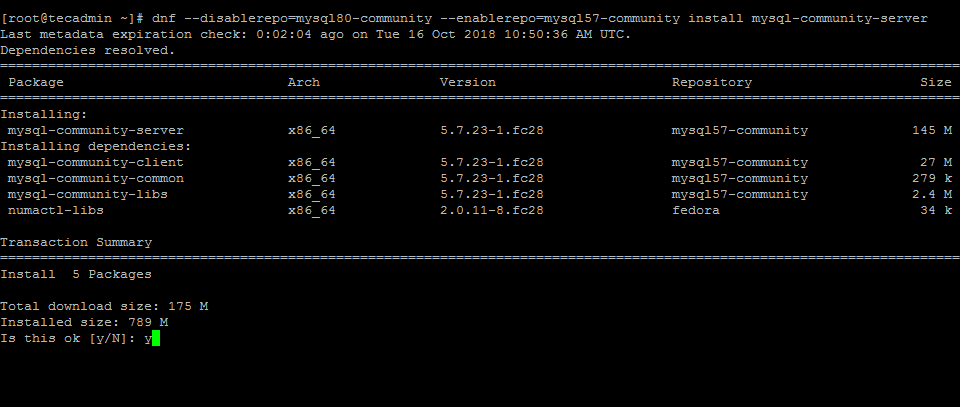
- #Commandline install for mysql on mac how to
- #Commandline install for mysql on mac mac os x
- #Commandline install for mysql on mac install
- #Commandline install for mysql on mac upgrade
Also refer to the information provided in Section 2.9, “Installing MySQL from Source”.Īfter installing MySQL, see Section 2.10, “Postinstallation Setup and Testing”įor information about making sure the MySQL server is working
#Commandline install for mysql on mac install
To install MySQL from a source distribution or from the currentĭevelopment source tree, use the instructions in Instructions in Section 2.2, “Installing MySQL on Unix/Linux Using Generic Binaries”. To install MySQL from a binary distribution, use the Section 2.1.4, “Verifying Package Integrity Using MD5 Checksums or GnuPG”. The integrity of the distribution, use the instructions in Section 2.1.2, “Choosing Which MySQL Distribution to Install”.ĭownload the distribution that you want toįor instructions, see Section 2.1.3, “How to Get MySQL”. Version and type of distribution you should use, see

Source tree for those who want to see our most recentĭevelopments and help us test new code. We also provide public access to our current Pre-packaged distributions containing binary (precompiled) Several versions of MySQL are available, and most are available Known to run are officially supported by Oracle Corporation: Running MySQL, and that not all platforms on which MySQL is Please note that not all platforms are equally suitable for Installation of MySQL generally follows the steps outlined here:

If you are migrating from MySQL Enterprise Edition to MySQLĬommunity Server, see Section 2.11.2.2, “Downgrading from MySQL Enterprise Edition to MySQL Community Server”. System, you may wish to read Section A.8, “MySQL 5.5 FAQ: Migration”, whichĬontains answers to some common questions concerning migration If you are interested in migrating to MySQL from another database Procedures and about issues that you should consider before
#Commandline install for mysql on mac upgrade
Section 2.11.1, “Upgrading MySQL”, for information about upgrade

Rather than install MySQL for the first time, see Plan to upgrade an existing version of MySQL to a newer version The procedure follows and later sections provide the details.
#Commandline install for mysql on mac how to
This chapter describes how to obtain and install MySQL.
#Commandline install for mysql on mac mac os x
Table of Contents 2.1 General Installation Guidance 2.1.1 Operating Systems Supported by MySQL Community Server 2.1.2 Choosing Which MySQL Distribution to Install 2.1.3 How to Get MySQL 2.1.4 Verifying Package Integrity Using MD5 Checksums or GnuPG 2.1.5 Installation Layouts 2.1.6 Compiler-Specific Build Characteristics 2.2 Installing MySQL on Unix/Linux Using Generic Binaries 2.3 Installing MySQL on Microsoft Windows 2.3.1 MySQL Installation Layout on Microsoft Windows 2.3.2 Choosing An Installation Package 2.3.3 Installing MySQL on Microsoft Windows Using MySQL Installer 2.3.4 MySQL Notifier 2.3.5 Installing MySQL on Microsoft Windows Using an MSI Package 2.3.6 MySQL Server Instance Configuration Wizard 2.3.7 Installing MySQL on Microsoft Windows Using a noinstall Zip Archive 2.3.8 Troubleshooting a Microsoft Windows MySQL Server Installation 2.3.9 Upgrading MySQL on Windows 2.3.10 Windows Postinstallation Procedures 2.4 Installing MySQL on Mac OS X 2.4.1 General Notes on Installing MySQL on Mac OS X 2.4.2 Installing MySQL on Mac OS X Using Native Packages 2.4.3 Installing the MySQL Startup Item 2.4.4 Installing and Using the MySQL Preference Pane 2.4.5 Using the Bundled MySQL on Mac OS X Server 2.5 Installing MySQL on Linux 2.5.1 Installing MySQL on Linux Using RPM Packages 2.5.2 Installing MySQL on Linux Using Debian Packages 2.5.3 Installing MySQL on Linux Using Native Package Managers 2.6 Installing MySQL Using Unbreakable Linux Network (ULN) 2.7 Installing MySQL on Solaris and OpenSolaris 2.7.1 Installing MySQL on Solaris Using a Solaris PKG 2.7.2 Installing MySQL on OpenSolaris Using IPS 2.8 Installing MySQL on FreeBSD 2.9 Installing MySQL from Source 2.9.1 MySQL Layout for Source Installation 2.9.2 Installing MySQL Using a Standard Source Distribution 2.9.3 Installing MySQL Using a Development Source Tree 2.9.4 MySQL Source-Configuration Options 2.9.5 Dealing with Problems Compiling MySQL 2.9.6 MySQL Configuration and Third-Party Tools 2.10 Postinstallation Setup and Testing 2.10.1 Postinstallation Procedures for Unix-like Systems 2.10.2 Securing the Initial MySQL Accounts 2.11 Upgrading or Downgrading MySQL 2.11.1 Upgrading MySQL 2.11.2 Downgrading MySQL 2.11.3 Checking Whether Tables or Indexes Must Be Rebuilt 2.11.4 Rebuilding or Repairing Tables or Indexes 2.11.5 Copying MySQL Databases to Another Machine 2.12 Environment Variables 2.13 Perl Installation Notes 2.13.1 Installing Perl on Unix 2.13.2 Installing ActiveState Perl on Windows 2.13.3 Problems Using the Perl DBI/DBD Interface


 0 kommentar(er)
0 kommentar(er)
